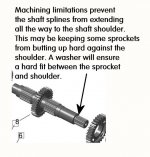Very possibly, what you posted is correct, one time interim inspection that was expected to allow the sprocket / pulley to “survive” until this permanent replacement is installed.
Just yesterday, I was discussing with an owner in Arizona, he was taking my advice to remove the pulley himself, inspect, clean and lubricate the splines, then reassemble. In his case, the front pulley was stuck on the splined shaft. He was able to remove the pulley without extra, but minimal fuss.
I explained that the particles created from the splines fretting corrosion were lodged between the gearbox shaft splines and pulley splines. This prevented the pulley from simply sliding off the gearbox shaft. Regarding these interim inspections, this persons pulley would have had a clearance of zero, since the fretting debris removed all clearance and had the pulley stuck to the shaft.
With the pulley removed, after cleaning he could visibly some wear that went along with the “red dust” of particles. For this person, he had no concerns as he installed a new pulley wet with moly paste, a new bolt, and torqued to specs.
We both agreed that unless the pulley is removed from the shaft, followed by cleaning the gearbox shaft splines and pulley splines completely using a toothbrush or similar and solvent, then sliding the clean parts together for rotational freeplay inspection, there is no way to accurately measure the true clearance with the recall inspection method. Granted, a badly worn pulley can be obvious, but a marginal pulley may be incorrectly returned to service.
Hopefully, as one well respected Can Am tech has publicly stated, the worn pulleys are not common.

